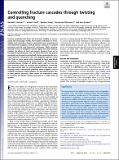| dc.contributor.author | Heisser, Ronald Henry | |
| dc.contributor.author | Patil, Vishal P. | |
| dc.contributor.author | Stoop, Norbert | |
| dc.contributor.author | Villermaux, Emmanuel | |
| dc.contributor.author | Dunkel, Jörn | |
| dc.date.accessioned | 2020-03-24T11:32:08Z | |
| dc.date.available | 2020-03-24T11:32:08Z | |
| dc.date.issued | 2018-08 | |
| dc.date.submitted | 2018-02 | |
| dc.identifier.issn | 1091-6490 | |
| dc.identifier.issn | 0027-8424 | |
| dc.identifier.uri | https://hdl.handle.net/1721.1/124218 | |
| dc.description.abstract | Fracture fundamentally limits the structural stability of macroscopic and microscopic matter, from beams and bones to microtubules and nanotubes. Despite substantial recent experimental and theoretical progress, fracture control continues to present profound practical and theoretical challenges. While bending-induced fracture of elongated rod-like objects has been intensely studied, the effects of twist and quench dynamics have yet to be explored systematically. Here, we show how twist and quench protocols may be used to control such fracture processes, by revisiting Feynman's observation that dry spaghetti typically breaks into three or more pieces when exposed to large pure bending stresses. Combining theory and experiment, we demonstrate controlled binary fracture of brittle elastic rods for two distinct protocols based on twisting and nonadiabatic quenching. Our experimental data for twist-controlled fracture agree quantitatively with a theoretically predicted phase diagram, and we establish asymptotic scaling relations for quenched fracture. Due to their general character, these results are expected to apply to torsional and kinetic fracture processes in a wide range of systems. ©2018 Keywords: fracture cascade; elastic rods; scaling laws | en_US |
| dc.language.iso | en | |
| dc.publisher | National Academy of Sciences | en_US |
| dc.relation.isversionof | 10.1073/PNAS.1802831115 | en_US |
| dc.rights | Article is made available in accordance with the publisher's policy and may be subject to US copyright law. Please refer to the publisher's site for terms of use. | en_US |
| dc.source | PNAS | en_US |
| dc.title | Controlling fracture cascades through twisting and quenching | en_US |
| dc.type | Article | en_US |
| dc.identifier.citation | Heisser, Ronald H., et al. "Controlling Fracture Cascades through Twisting and Quenching."
Proceedings of the National Academy of Sciences 15, 35 (Aug. 2018): 8665-8670; DOI: 10.1073/pnas.1802831115 ©2018 Author(s) | en_US |
| dc.contributor.department | Massachusetts Institute of Technology. Department of Mathematics | en_US |
| dc.contributor.department | MultiScale Materials Science for Energy and Environment, Joint MIT-CNRS Laboratory | en_US |
| dc.relation.journal | Proceedings of the National Academy of Sciences of the United States of America | en_US |
| dc.eprint.version | Final published version | en_US |
| dc.type.uri | http://purl.org/eprint/type/JournalArticle | en_US |
| eprint.status | http://purl.org/eprint/status/PeerReviewed | en_US |
| dc.date.updated | 2019-11-12T15:29:45Z | |
| dspace.date.submission | 2019-11-12T15:30:00Z | |
| mit.journal.volume | 15 | en_US |
| mit.journal.issue | 35 | en_US |
| mit.metadata.status | Complete | |
